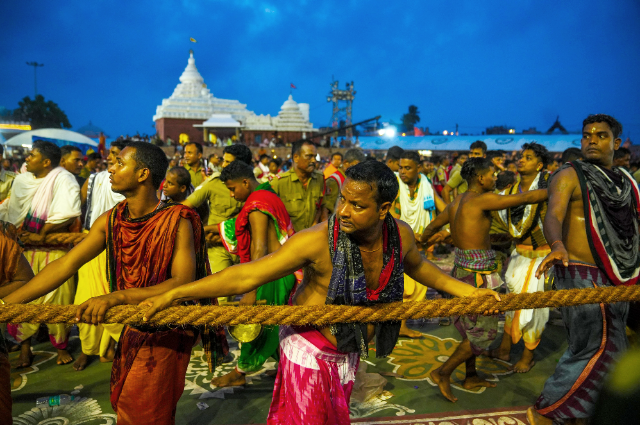As the dawn breaks, an immense congregation of devotees has converged upon the respected Jagannath Temple in Puri. They are here to witness and participate in the auspicious commencement of Lord Jagannath's Rath Yatra, a globally renowned Hindu festival that epitomizes devotion and spiritual pursuit. Also, recognized as the Chariot Festival or Shree Gundicha Yatra, this annual celebration holds profound significance for millions particularly in the Indian state of Odisha where it originates.
The Rath Yatra is meticulously observed on the Dwitiya Tithi, which marks the second day of the Shukla Paksha the waxing phase of the moon within the Hindu lunar calendar. This specific timing is considered highly spiritually auspicious due to the progressive illumination of the moon, symbolizing growth and enlightenment which adds to the sanctity of the festival.
The World's Most Ancient Chariot Festival
Highlighting the historical and spiritual grandeur of the event, Suryanarayan Rath Sharma, a distinguished scholar specializing in Jagannath culture had shared insights with IANS. He emphasized that the Rath Yatra stands as the "most ancient chariot festival in the world." This historical depth underscores its enduring cultural and religious importance. Furthermore, Sharma articulated a deeply held belief among devotees by experiencing the divine presence or darshan of Lord Jagannath during this sacred procession is believed to bestow moksha upon a devotee which is the liberation from the cycle of rebirth and attainment of ultimate spiritual salvation. This promise of spiritual liberation draws countless individuals to Puri each year.
A Million-Strong Pilgrimage: The Divine Stay
Indeed, millions of devotees have gathered to create a sea of humanity eager to partake in the famous Ratha Yatra. Today marks the pivotal moment when Lord Jagannath, accompanied by his elder brother Balabhadra and younger sister Subhadra and they will embark on their nine-day spiritual journey. This divine procession sees them departing from their traditional abode and the magnificent 12th-century shrine of the Jagannath Temple and proceeding towards the Gundicha Temple. This annual sojourn is not merely a parade but a profound pilgrimage by symbolizing the deities' annual visit to their birthplace or a garden house by offering a unique opportunity for their followers to connect with the divine.
A Sea of Devotion Pulls the Sacred Chariots
As the Rath Yatra officially begins, an intense wave of ecstasy washes over the assembled devotees. Their faith finds expression in the monumental task of pulling the colossal chariots of Lord Jagannath, Lord Balabhadra, and Goddess Subhadra. Each deity has a designated chariot: Nandighosh for Lord Jagannath, Taladhwaja for Lord Balabhadra, and Darpadalan for Goddess Subhadra. This inspirational procession will traverse approximately 3 kilometres by making its way to the revered Gundicha Temple. For many, this temple holds a significance that is believed by some legends to be the sacred birthplace of the Chaturddha Murti and the divine quartet comprising Lord Jagannath, Lord Balabhadra, Maa Subhadra, and Sudarshan. This journey is not merely a physical act but a deeply spiritual undertaking and a testament to unwavering devotion.
Meticulous Preparations for a Seamless Celebration
Ensuring the smooth execution of an event of such immense scale and spiritual importance requires meticulous planning and co-ordination. Various departments of the state government have undertaken elaborate preparations to guarantee a smooth and incident-free Rath Yatra. Every detail which includes from crowd management to security and public amenities, it has been carefully considered to facilitate a safe and sacred experience for all attendees.
The commitment to a successful Rath Yatra was clearly articulated by Sidharth Shankar Swain the Collector of Puri. He affirmed, “We are fully prepared for the grand Rathayatra. All rituals and arrangements have been meticulously planned and will be carried out with equal dedication.” His statement reflects the diligent efforts undertaken by the administration. Furthermore, Swain extended an appeal for collective participation and divine grace, adding that “I seek the blessings of Mahaprabhu and the cooperation of all devotees to ensure a smooth and sacred celebration.” This sentiment underscores the collaborative spirit required to host such a monumental spiritual gathering, emphasizing both human effort and divine kindness for a truly blessed Rath Yatra.
Sacred Timing and Ritual Sequence
The festival is celebrated on the Dwitiya Tithi, which is the second lunar day of the bright fortnight (Shukla Paksha) of the Hindu month Asadha. This month typically falls in June or July in the Gregorian calendar. In 2025, the festivities officially commence on June 12 with Snana Purnima and a sacred ritual during which the deities are ceremonially bathed. Following this, the idols are kept away from public view in a period called Anavasara, lasting from June 13 to June 26. During this time, it is believed that the deities are recovering from the physical exhaustion caused by the elaborate bathing ritual.
According to Drik Panchang, in 2025, the auspicious Dwitiya Tithi begins at 1:24 PM on June 26 and ends at 11:19 AM on June 27. Consequently, the main event is the Rath Yatra procession which will take place on June 27, 2025. On this day, Lord Jagannath, Lord Balabhadra, and Goddess Subhadra are placed on massive, beautifully decorated wooden chariots and pulled through the streets by thousands of devotees.
Symbolism and Spiritual Significance
The Rath Yatra is more than just a ritual procession and it carries deep symbolic meaning. It represents Lord Jagannath’s divine journey from his temple by symbolizing the celestial world to the streets which symbolise the earthly realm in order to bless and connect with his devotees. In a broader sense, the Yatra is seen as a metaphor for the journey of life and the soul’s quest for liberation.
There is also a spiritual legend associated with this event. As per Hindu belief, during this journey, Lord Jagannath is said to be returning to his birthplace, Mathura. Devotees who participate by pulling the chariots or touching the ropes are believed to receive divine blessings and forgiveness for their sins, making the experience both emotionally moving and spiritually uplifting.
. . .
References:

